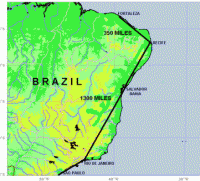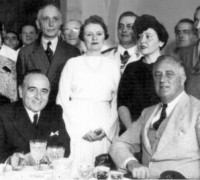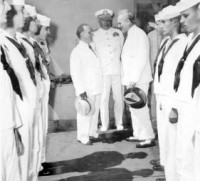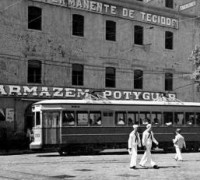MILITARY RELATIONS WITH BRAZIL BEFORE PEARL HARBOR - BRAZIL X USA MILITARY RELATIONS
3)MUNITIONS FOR BRAZIL 1941
Colonel McCunniff's report on the joint planning effort in Brazil noted, "it was apparent from the first meeting that the major objective in so far as the Brazilian group was concerned was to secure arms and equipment from the United States." The United States Army sincerely wanted to supply arms to Brazil, but, as earlier, it could not see how an adequate supply of arms could be arranged in time to enable the Brazilians to assume the ground and air defense of Northeast Brazil.
The basic arms supply program for Latin America that the War and Navy Departments had approved in March 1941 allocated munitions valued at $100,000,000 to Brazil, four fifths of which was to be used for ground and air equipment, but most of these munitions were not to be delivered until after 1 July 1942. In April 1941 the Army planned the eventual delivery of 230 military aircraft to Brazil, and in the same month President Roosevelt extended the coverage of the Lend- Lease Act to Brazil as well as to the other Latin American republics.
Pending conclusion of a lend-lease agreement with Brazil and at the Army's insistence, the United States had, as already noted, made a $12,000,000 credit available to the Brazilians for military purchases. Brazil never used this credit, the Brazilian Minister of Finance preferring to wait until his country could take advantage of the more liberal terms embodied in the lend-lease agreement signed on 1 October 1941.
The agreement, following exactly the terms of the March 1941 program, promised the delivery of $16,000,000 worth of Army and Navy material to Brazil by September 1942, and the remainder ($84,000,000 worth) sometime thereafter. By the end of November, Brazil had submitted lend-lease requisitions calling for an expenditure of $35,000,000 for ground equipment, or nearly one half of the $74,000,000 then allocated for the Brazilian Army.
In contrast with this extensive planning, the actual deliveries of modern military equipment to Brazil before Pearl Harbor consisted of only a few searchlights and a token shipment of automotive equipment and light tanks.
When the United States Army suddenly decided in May 1941 that, if possible, it ought to put some American troops into Brazil at once, it had also arranged to divert from its own forces to those of Brazil a million-dollar token shipment of 167 trucks, 10 scout cars, and 10 light tanks, together with a small quantity of ammunition for the guns on the scout cars and tanks. Brazil wanted this material for its newly established Armored Force--only it wanted 90 light and medium tanks immediately instead of the 10 light tanks offered.
The Army planned to get the proffered material aboard ship by the end of July so that some of it could appear in the Brazilian Independence Day parade on 7 September. After some delay, Brazil accepted most of the material and paid for it in cash. It reached Brazil in time to appear in the parade, and, according to General Miller, its appearance "produced a very favorable reaction in Brazilian Army circles."
This token shipment nevertheless represented only a small fraction of what the Brazilian Army currently believed it needed, and, as Foreign Minister Aranha pointed out to Ambassador Caffery, it was not suitable equipment for defending the Natal region. Efforts of the United States during 1941 to provide some modern military aircraft for Brazil did more harm than good. Though the Brazilians had about two hundred military planes, they had very few tactical aircraft, and no modern ones.
In the midst of the May crisis, General Marshall announced in a Standing Liaison Committee meeting that the Army was then trying to obtain the immediate release of twenty modern light bombers (A-20's) to Brazil from British allocations--British representatives in Washington having intimated that this could be done.
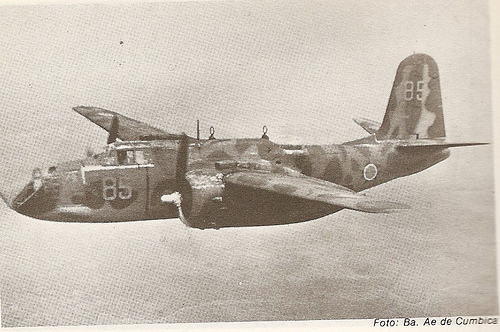
Douglas A-20 Boston. Brazilian Air Force received 20 of K Model
General Arnold thereupon personally informed General Miller at Rio that twelve of the planes could probably be released to the Brazilians immediately, if they wanted them. The Brazilians wanted them very much, even though they had no pilots qualified to fly A-20's. When British authorities in London refused to release the planes to Brazil, the reaction in Rio de Janeiro was most unfavorable.
General Miller urged that some substitute offer be made at once. As substitutes, he suggested transport planes for the air-mail service operated by the Brazilian Air Force and assignment to the United States Air Mission of a few B-18's--medium bombers of a slow and obsolete type--that would permit a transitional type of training for Brazilian pilots to prepare them to operate more modern aircraft.
Between August 1941 and January 1942 the United States Army worked out a solution to the problem of providing military planes to Brazil. No modern combat aircraft were to be made available to Brazil before the autumn of 1942, but it did not appear that Brazil could train pilots to fly them before then in any event. What the Brazilian Air Force needed was modern training equipment--primary trainers first and basic trainers thereafter--to qualify its pilots for the operation of high-speed aircraft. In the fall of 1941 the Brazilians planned a pilot training program to begin in February 1942.
To provide airplanes for the program, the United States agreed to release sixty primary trainers to Brazil, fifteen of them in November 1941 and the balance in monthly increments, and fifty basic trainers at a rate of ten a month from February through June 1942. The United States also planned to furnish the Brazilian Air Force with some transport planes during 1942.
As an interim measure, General Miller proposed and the Army Air Forces in October 1941 approved the assignment to the United States Air Mission before the end of 1941 of a few B-18's and P-36's for use in instructing Brazilian Air Force pilots. Despite all this planning, the only United States military aircraft made available for Brazilian use before Pearl Harbor were the three primary trainers previously assigned to the Air Mission for instructional purposes.
If the United States had been able to supply the Brazilian Army and Air Force with a substantial amount of modern combat material in 1941, the Brazilians might have been willing to receive small United States Army forces in Northeast Brazil to help guard its vital airfields and to service the military air traffic that in June 1941 began to flow from the United States to Africa via Brazil.
This the United States could not do, as pointed out by General Marshall on 24 October in a letter to Mr. Welles: We do not have and for a considerable period of time we will not have, munitions to supply to Brazil of the type Brazil desires. The latter types are being and will continue to be supplied in proportion as our acute shortages are relieved, and on a priority higher than that accorded to any other Government not actually engaged in fighting the Axis.
The requirements of our own forces, of the British, and of other Governments actually engaged in resisting aggression, take precedence over the needs of Brazil. These decisions have been reached by superior agencies of our Government in the light of our own national interests and the world situation. The War Department contemplates no change. Under these circumstances, about all the United States Army had been able to do before Pearl Harbor was to prepare the way for supplying arms to Brazil in quantity by late 1942 and 1943.
Transcribed by Patrick Clancey – Hyper War Foundation
